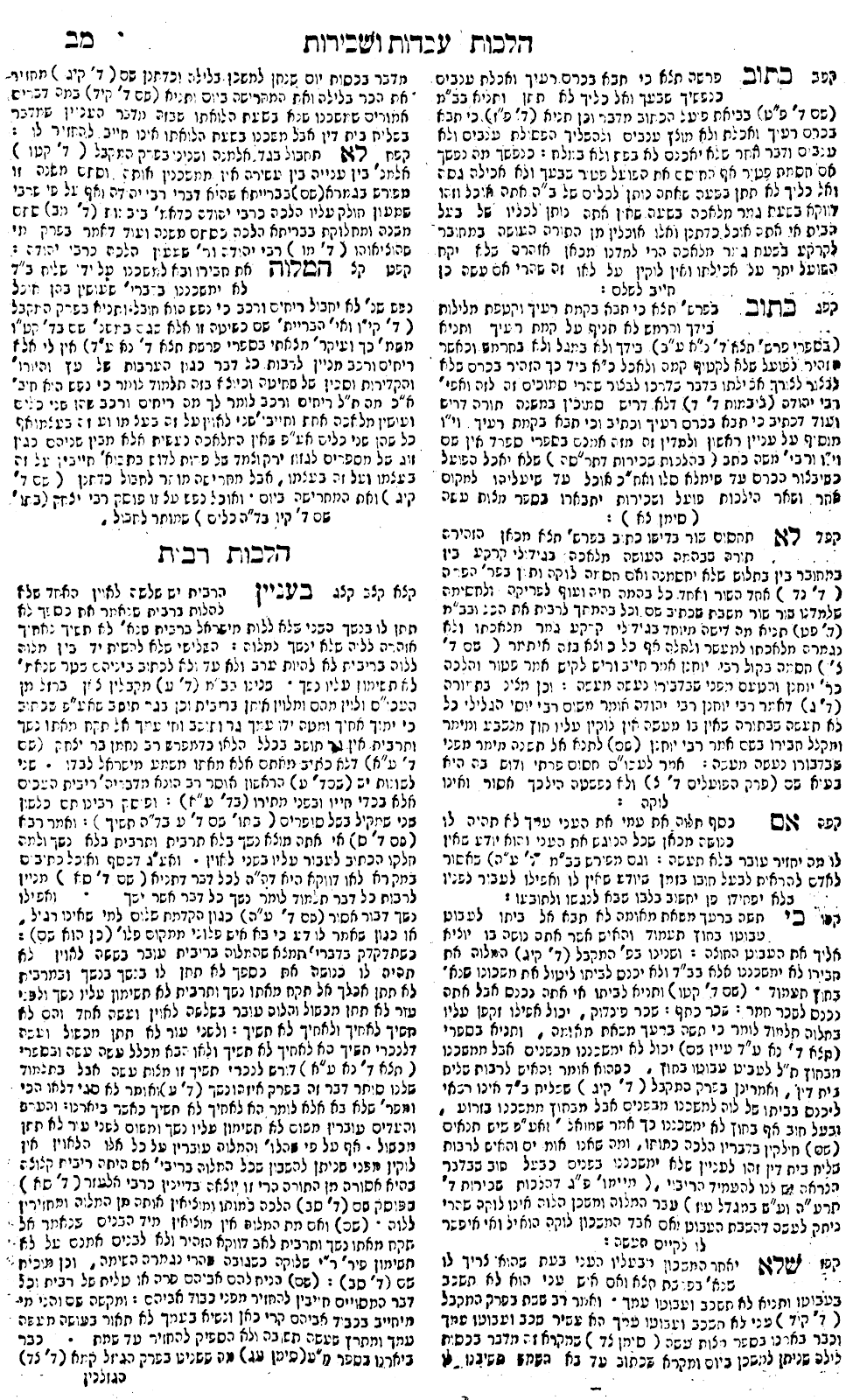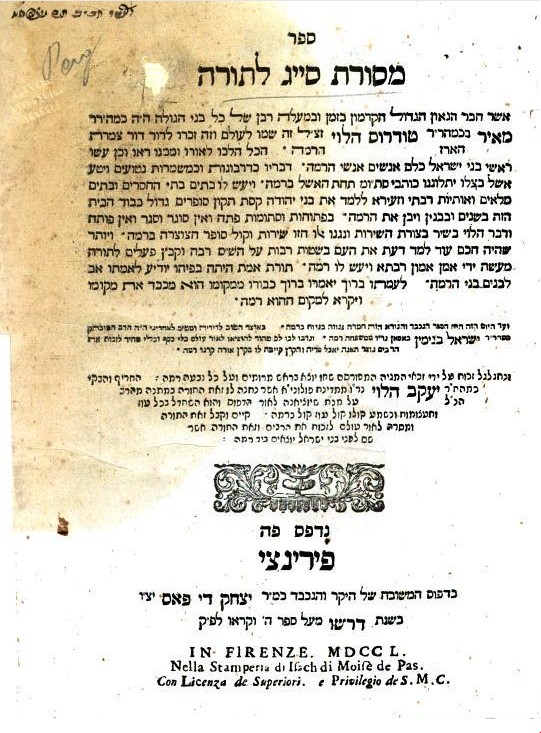(Cross-posted to Girsology.)
In the middle of parshat Ki Teitzei [Devarim 23:25-26], we read:

כִּי תָבֹא בְּקָמַת רֵעֶךָ -- in Sema'g [Sefer Mitzvot Gedolot] the volume on Lavin, siman 183, the following language is written:
And I am wondrously astonished at this, for I have not seen nor heard in my days that there is a dispute in this matter, neither in the Bavli nor Yerushalmi. And if someone should whisper to you that we don't know the facts of the matter clearly [such that this introduces uncertainty], tell him that from the Masoret we know that it is written without a vav, and the Gadol HaDor has said it -- and who is this? Rama [Rabbi Meir Abulafia] who wrote this in his Masorot, that within the entire sefer Devarim, the beginning of each pasuk is כִּי except for eight instances in which the beginning of the pasuk is וְכִי. And the sign is ... [then he lists the eight pesukim. Those eight pesukim are, in the same order:
End quote of Minchas Shai.
We can see the Semag in full here, in the second paragraph (183) on the right hand side:

The author of Sefer Mitzvos Gedolos, namely Rabbi Moshe ben Yaakov of Coucy, was a French Tosafist in the first half of the 13th century.
Here is the Likutei HaMasoret from the Rama, Rabbi Meir Abulafia, just as Minchas Shai recorded it. However, since the Rama lived and operated in Spain and so would naturally describe the state of Sefardic precise texts, and the Semag explicitly says that the Sefardic texts don't have this, this might be of limited utility. Obviously Minchas Shai maintains that it is an effective Masoret. At any rate, at the end of Masoret Seyag Lechachma, here is what we find:

Looking to Vetus Testamentum to see if there is any text with וכי in this pasuk, there is nothing. Namely, he lists Cod 300, but that is Minchas Shai!
When we look up at the end of Vetus Testamentum to see what this text is, we see that #300 is a printed text, and more specifically, is Minchas Shai's commentary. As the author explains here:
:
In the middle of parshat Ki Teitzei [Devarim 23:25-26], we read:

Minchas Shai writes regarding this:
It is written in parashat Ki Teitzei, כִּי תָבֹא בְּקָמַת רֵעֶךָ etc., and [תניא] we learn in a brayta, בְּיָדֶךָ and not with a sickle or a scythe. And just as it warned the worker not to grab the standing grain and eat eat, except by hand, so did it warn by a vineyard not to harvest for his [own] eating with something with which one usually harvests, for behold, they are juxtaposed one to the other, and this is even according to Rabbi Yehuda that we don't darshen semuchin [juxtapositions], in Mishneh Torah [meaning sefer Devarim], he does darshen semuchin. And furthermore, since it is written [in pasuk 25] כִּי תָבֹא בְּכֶרֶם רֵעֶךָ, and it is written וְכִי תָבֹא בְּקָמַת רֵעֶךָ, the vav [of וְכִי] adds on the first matter, and we learn one from the other." However, in Sefardic sefarim, there is no vav present.End quote [of Semag].
And I am wondrously astonished at this, for I have not seen nor heard in my days that there is a dispute in this matter, neither in the Bavli nor Yerushalmi. And if someone should whisper to you that we don't know the facts of the matter clearly [such that this introduces uncertainty], tell him that from the Masoret we know that it is written without a vav, and the Gadol HaDor has said it -- and who is this? Rama [Rabbi Meir Abulafia] who wrote this in his Masorot, that within the entire sefer Devarim, the beginning of each pasuk is כִּי except for eight instances in which the beginning of the pasuk is וְכִי. And the sign is ... [then he lists the eight pesukim. Those eight pesukim are, in the same order:
דברים פרק יד]
דברים פרק טו
- פסוק כ"ד: וְכִי-יִרְבֶּה מִמְּךָ הַדֶּרֶךְ, כִּי לֹא תוּכַל שְׂאֵתוֹ--כִּי-יִרְחַק מִמְּךָ הַמָּקוֹם, אֲשֶׁר יִבְחַר יְהוָה אֱלֹהֶיךָ לָשׂוּם שְׁמוֹ שָׁם: כִּי יְבָרֶכְךָ, יְהוָה אֱלֹהֶיךָ.
דברים פרק יח
- פסוק י"ג: וְכִי-תְשַׁלְּחֶנּוּ חָפְשִׁי, מֵעִמָּךְ--לֹא תְשַׁלְּחֶנּוּ, רֵיקָם.
- פסוק כ"א: וְכִי-יִהְיֶה בוֹ מוּם, פִּסֵּחַ אוֹ עִוֵּר, כֹּל, מוּם רָע--לֹא תִזְבָּחֶנּוּ, לַיהוָה אֱלֹהֶיךָ.
דברים פרק יט
- פסוק ו: וְכִי-יָבֹא הַלֵּוִי מֵאַחַד שְׁעָרֶיךָ, מִכָּל-יִשְׂרָאֵל, אֲשֶׁר-הוּא, גָּר שָׁם; וּבָא בְּכָל-אַוַּת נַפְשׁוֹ, אֶל-הַמָּקוֹם אֲשֶׁר-יִבְחַר יְהוָה.
- פסוק כ"א: וְכִי תֹאמַר, בִּלְבָבֶךָ: אֵיכָה נֵדַע אֶת-הַדָּבָר, אֲשֶׁר לֹא-דִבְּרוֹ יְהוָה.
דברים פרק כא
- פסוק י"א: וְכִי-יִהְיֶה אִישׁ, שֹׂנֵא לְרֵעֵהוּ, וְאָרַב לוֹ וְקָם עָלָיו, וְהִכָּהוּ נֶפֶשׁ וָמֵת; וְנָס, אֶל-אַחַת הֶעָרִים הָאֵל.
דברים פרק כג
- פסוק כ"ב: וְכִי-יִהְיֶה בְאִישׁ, חֵטְא מִשְׁפַּט-מָוֶת--וְהוּמָת: וְתָלִיתָ אֹתוֹ, עַל-עֵץ.
- פסוק כ"ג: וְכִי תֶחְדַּל, לִנְדֹּר--לֹא-יִהְיֶה בְךָ, חֵטְא.
End quote of Minchas Shai.
We can see the Semag in full here, in the second paragraph (183) on the right hand side:
The author of Sefer Mitzvos Gedolos, namely Rabbi Moshe ben Yaakov of Coucy, was a French Tosafist in the first half of the 13th century.
Here is the Likutei HaMasoret from the Rama, Rabbi Meir Abulafia, just as Minchas Shai recorded it. However, since the Rama lived and operated in Spain and so would naturally describe the state of Sefardic precise texts, and the Semag explicitly says that the Sefardic texts don't have this, this might be of limited utility. Obviously Minchas Shai maintains that it is an effective Masoret. At any rate, at the end of Masoret Seyag Lechachma, here is what we find:
Looking to Vetus Testamentum to see if there is any text with וכי in this pasuk, there is nothing. Namely, he lists Cod 300, but that is Minchas Shai!
When we look up at the end of Vetus Testamentum to see what this text is, we see that #300 is a printed text, and more specifically, is Minchas Shai's commentary. As the author explains here:
:
Cod. 300, Biblia impressa, merito celibratissima, Minchath Shai; de quo jam fusius egi, $62. Addam tantum, Notas hic effe signitas 300; Textum vero, 300 T.I don't speak Latin, so here is my best guess (with a little help from Google Translate.)
Bible, printed, deservedly celebrated, Minchath Shai; of which I have done already in more detail, $ 62. I will show his comments as 300; The text, itself, as 300 T.Here is the printed TaNaCh with Minchas Shai, with text כי and comment from Minchas Shai about the Semag and וכי:





2 comments:
The Semag is quoting the Yerei'im, by the way.
thanks! yes, found it.
http://hebrewbooks.org/pdfpager.aspx?req=32706&st=&pgnum=127
since the author of sefer yereim, rabbi eliezer ben shmuel mi-metz, passed away in 1175, that brings this witness to a variant text that much earlier. same place, France.
Post a Comment